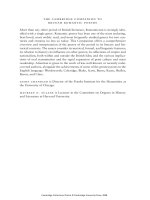The cambridge companion to british roman 52
Bạn đang xem bản rút gọn của tài liệu. Xem và tải ngay bản đầy đủ của tài liệu tại đây (39.01 KB, 1 trang )
j e f f r e y n . c ox
might be seen in these tales, including the ottava rima “Isabella,” following
Byron and his “Liberal Don” in using the tale to explore the world, rather
than Wordsworth, who would rather be at home in Grasmere.
We can think of other juxtapositions. We might want to think of the sceptical “Lamia” alongside Hemans’s Sceptic. We might want to consider “The
Eve of St. Agnes” next to 1820’s Ivy Castle; or, The Eve of St. Agnes, a prose
work by Sarah Scudgell Wilkinson. “Isabella” is part of an extensive engagement with Italian literature that can be traced to Hunt’s seminal romance,
The Story of Rimini. We might also find new contexts for the volume’s closing
narrative poem, “Hyperion,” called an “unfinished poem” in an “Advertisement” that Keats abjured, and often considered yet another example of a
failed Romantic epic. This notion of the failed epic is essential to our construction of the Romantic movement as primarily lyric, but it is a notion
that does not stand up to much scrutiny. Blake may have abandoned The
Four Zoas, but he did complete long poems such as Milton and Jerusalem.
If Wordsworth never finished the massive “Recluse” project, he was known
at the time for the epic-length The Excursion, and he also completed The
Prelude, though he left it to be published after his death. Byron completed
his long romance of Childe Harold, and, though Don Juan is unfinished,
that is because Byron died. Southey completed more epic-length poems than
his critics thought wise; Scott finished long narrative poems, as did Moore,
Shelley, Hunt, and many others. Now it may be that the Romantics did not
write a poem to rival Paradise Lost, but while they certainly sought to rework
that poem, it is not clear that their central goal was to replicate it rather than
replace it. We might want to read “Hyperion” against contemporary epic
attempts such as Barrett’s The Battle of Marathon, but we can also see it as
part of a Cockney effort to turn from the martial epic to the erotic and fanciful epyllion.34 Again, we might note that the placement of this “Grecian”
epic at the close of the volume parallels the inclusion of translations from the
Greek and elsewhere at the end of volumes such as Hunt’s Foliage (1818),
or we might want to place it against projects such as Landor’s 1820 Idyllia
Heroica Decem, with its Latin poems. We might want to read “Hyperion,”
then, not as a failed attempt to return to Milton or Homer but as a successful modern, Cockney effort to open up British literature to the world and
to open up the classics to the kinds of readers and writers that conservative
protectors of the canon feared would dilute and dirty the pure waters of a
Hippocrene of cultural capital.
With its unfamiliar pantheon of Titans, “Hyperion” might be seen – like
Keats’s 1820 volume as a whole – as another opening on to the pantheon of
living poets in 1820. Even if we wish to celebrate the canonical Keats, we
can do so only if we understand how his experimental verse defines itself
30
Cambridge Collections Online © Cambridge University Press, 2008









